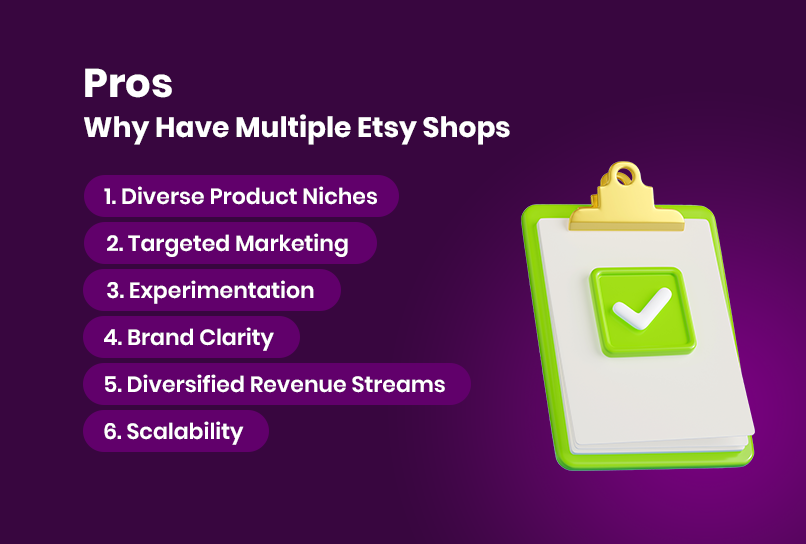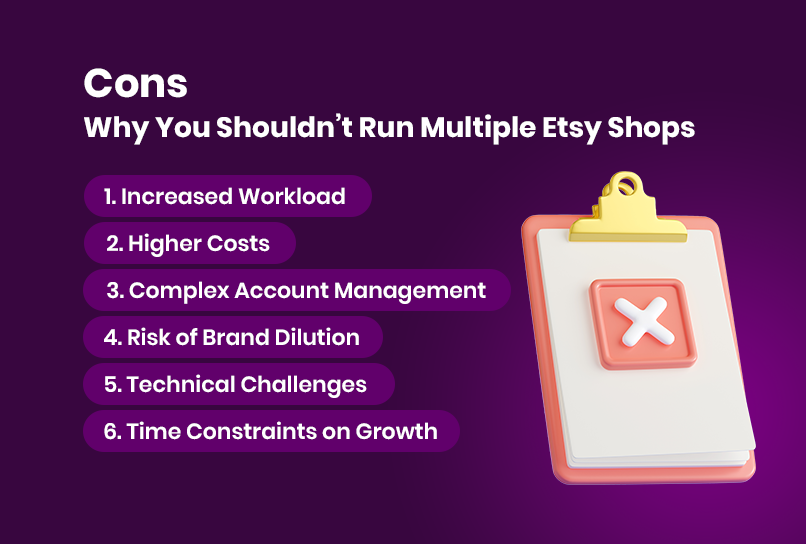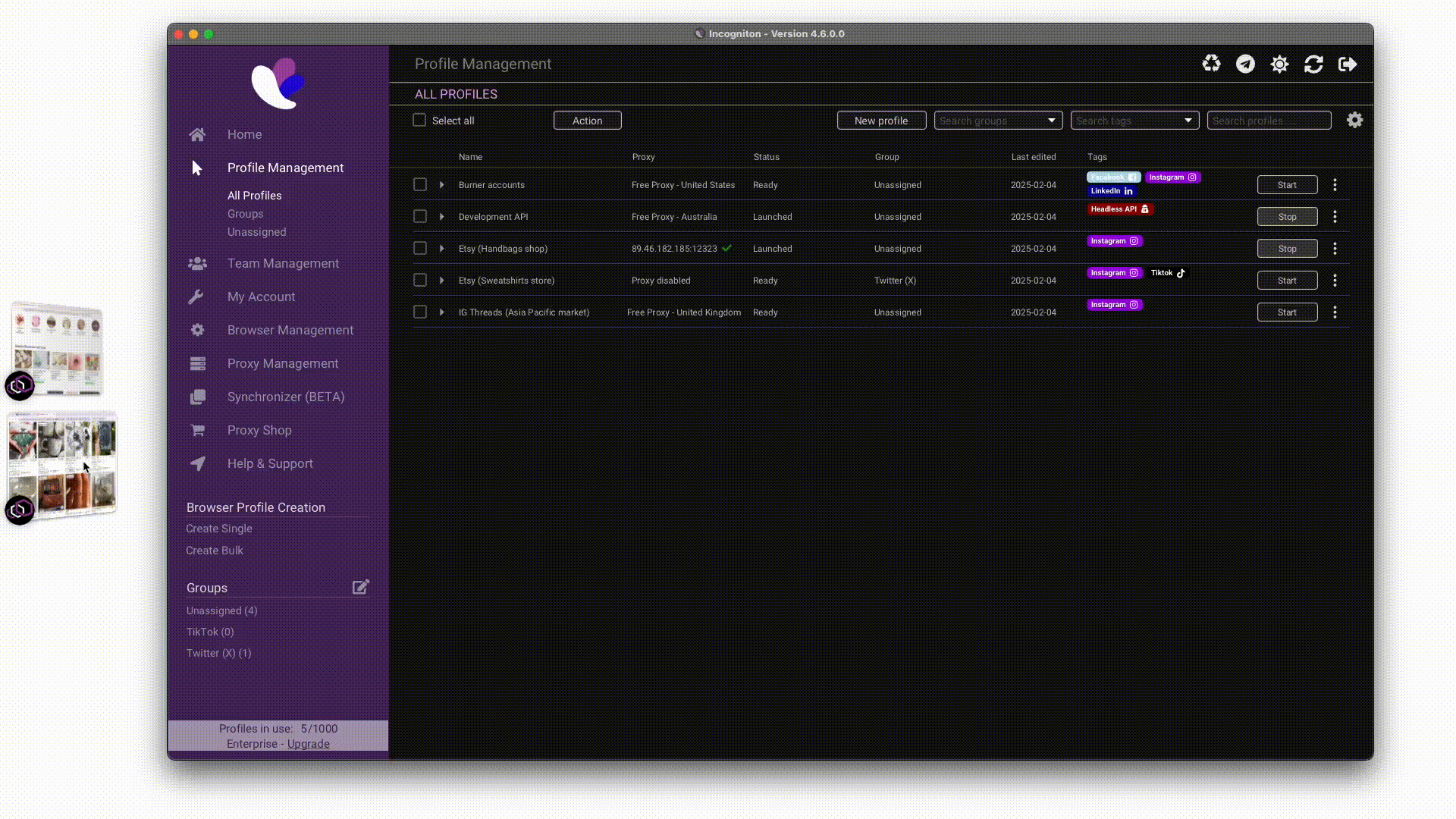Managing a single Etsy shop is already a juggling act, but what if you have multiple creative passions or business ideas? Maybe you sell handmade jewelry but also have a knack for Sweatshirts, or you want to keep your vintage finds separate from your custom crafts.
Running multiple Etsy shops would be the perfect way to achieve these goals — to reach different audiences, test out new niches, and build distinct brand identities — all while maximizing your sales potential.
However, managing multiple Etsy stores sure comes with its challenges. From actively monitoring multiple accounts to having to stay compliant with Etsy’s policies — the famous House Rules, the process can feel overwhelming.
In this guide, we’ll explore the adventure of managing multiple shops on Etsy, whether or not it’s a good idea, the rules you need to follow, and how to open and manage them efficiently, especially with the help of Incogniton.
Can You Have Multiple Etsy Shops?
Yes, you can have multiple Etsy shops as long as you follow Etsy’s guidelines.
With over 96.71 million active buyers, Etsy offers sellers access to a vast customer base. This flexibility benefits both hobbyists seeking side income and entrepreneurs scaling into full-time businesses.
Running multiple shops helps target different markets and customer bases. For example, separating graphic design templates from handcrafted pottery keeps each shop focused and enhances the shopping experience.
Opening multiple shops is a great way to test new ideas and diversify income. However, it requires strategic planning, clear branding, and efficient workflow management. We will explicitly cover the pros and cons of managing multiple Etsy accounts in the later sections of the article.
Rules for Opening a Second Etsy Shop
If you’re planning to open a second Etsy shop, it’s crucial to followEtsy’s rules to ensure compliance and avoid penalties. Here are the key things to note from the platform’s guidelines:
1. Separate Email Addresses
Each Etsy shop must be registered with a unique email address. This distinction helps Etsy track activity and ensures smooth account management.
2. Transparency
Etsy requires sellers to disclose all their shops in the “About” section of each shop. This builds trust with customers and ensures you’re operating within Etsy’s guidelines.
3. Distinct Branding and Listings
To maintain clarity and avoid confusion, each shop should have its own branding, logos, and product listings. Overlapping content between shops could violate Etsy’s rules and confuse customers.
4. Adherence to Policies
All your shops must comply with Etsy’s terms of service, including listing policies, payment regulations, and customer communication guidelines.
How to Open Multiple Etsy Shops
Opening multiple stores on Etsy can be a fantastic way to diversify your business, but the process requires careful planning and execution. Here’s a detailed step-by-step guide to help you get started while staying compliant with Etsy’s policies:
Step 1: Plan Your Shop Concept
Before opening a new shop, clearly define its purpose and niche. Ask yourself:
- What products will this shop sell?
- How does this niche differ from my existing shop?
- Who is the target audience?
Why This Matters: A well-defined concept helps you maintain a cohesive brand identity and reach the right audience. For instance, if your first shop specializes in handmade jewelry, your second shop might focus on eco-friendly home decor.
Quick Tip: Conduct market research to identify trends, competitors, and gaps in the market. Tools like Google Trends and Etsy’s search bar can help you gauge customer interest in your chosen niche.
Step 2: Create a New Account
Etsy requires each shop to be registered with a unique email address. Use a fresh email to set up your second shop and ensure it’s not linked to your existing shop.
Step 3: Set Up Your Shop Details
When setting up your shop, focus on creating a distinct identity:
- Choose a name that aligns with the niche and is memorable.
- Design a unique logo and banner using tools like Canva or Adobe Express.
- Write a compelling shop description that highlights your shop’s unique selling points (USPs).
Why This Matters: A distinct identity helps your shop stand out and ensures customers aren’t confused by overlapping branding between shops.
Quick Tip: Use keywords in your shop name and descriptions to improve visibility in Etsy’s search results. For example, if your shop specializes in vintage clothing, include words like “vintage,” “retro,” or “classic” in your descriptions.
Step 4: Disclose Ownership
Etsy requires transparency about shop ownership. In the “About” section of each shop, disclose that you operate multiple shops.
Example Statement:
“In addition to this shop, I also run [Shop Name], which focuses on [niche]. This allows me to cater to different audiences and offer a wider range of products.”
Why This Matters: Transparency builds trust with your customers and ensures you stay compliant with Etsy’s policies.
Step 5: Optimize Workflow
Managing multiple shops can quickly become overwhelming without a proper system in place. Develop an organized workflow to track inventory, process orders, and respond to customer inquiries efficiently.
Tips for Success:
- Inventory management software is used to track stock across shops.
- Create a shared calendar or task list to schedule product launches, promotions, and order fulfillment deadlines.
- Dedicate specific time slots each day or week to managing each shop.
Pros — Why Have Multiple Etsy Shops
Running multiple Etsy shops offers numerous advantages, especially for sellers looking to expand their reach and maximize revenue. Here are the key reasons why having multiple Etsy shops might be a smart move:
1. Diverse Product Niches
If you sell products in vastly different categories, such as personalized wedding stationery and handmade ceramics, housing them in separate shops makes sense. Each shop can have its own cohesive branding, tailored descriptions, and distinct marketing strategies.
This separation ensures your customers enjoy a seamless shopping experience tailored to their specific interests. For example, a customer searching for elegant wedding invitations may not resonate with a shop that sells colorful bohemian pottery.
2. Targeted Marketing
Different shops allow you to cater to unique audiences with customized branding and marketing. A shop focused on eco-friendly products can use a sustainability-centered brand voice, while a shop selling luxury items might emphasize exclusivity and craftsmanship.
Separate shops help you optimize your marketing efforts, whether you’re running social media campaigns, email newsletters, or Etsy ads, to appeal directly to the preferences of your target customers.
3. Experimentation
Launching a new product idea often comes with uncertainties. By setting up a separate shop to test your idea, you can gauge customer interest without risking the reputation or sales performance of your main shop. For example, if you sell home decor items in one shop but want to experiment with handmade pet accessories, a second shop lets you test this new niche in isolation.
4. Brand Clarity
A clear and consistent brand identity is crucial for building trust and loyalty. Keeping product categories separate ensures that your branding doesn’t become diluted. Each shop can have its own logo, color palette, and messaging style, which helps customers feel a stronger connection to your brand.
5. Diversified Revenue Streams
An average Etsy seller made $1,236 in 2023. Imagine what you could do with more than one shop. Multiple shops can help you diversify your income sources, making your business more resilient to market fluctuations. If one shop experiences a slow season or reduced demand, the other shop(s) can help balance your revenue.
6. Scalability
For sellers aiming to turn their side hustle into a full-time business, multiple shops offer opportunities to scale. By catering to different niches and audiences, you can increase sales volume and explore new markets without overloading a single shop with unrelated products.
Ultimately, having multiple Etsy shops provides flexibility and a tailored approach to growing your business. However, managing multiple shops comes with challenges, so careful planning and the right tools are essential to make the most of this strategy.
Cons — Why You Shouldn’t Run Multiple Etsy Shops
Managing multiple Etsy shops has its benefits, but it also comes with significant challenges. Before deciding to expand your business across multiple accounts, consider the potential downsides to ensure it’s the right move for you.
1. Increased Workload
Operating one Etsy shop is already a time-consuming endeavor. When you multiply that by two or more, the workload grows exponentially. Each shop requires separate attention for tasks like inventory management, order fulfillment, customer support, and marketing.
If you’re not prepared to manage this additional workload, you risk providing subpar service or failing to keep up with orders, which could damage your reputation.
Quick Tip: Use scheduling tools and streamlined workflows to handle repetitive tasks efficiently. For example, pre-planning product launches or automating email responses can save valuable time.
2. Higher Costs
Running multiple shops often comes with additional expenses. These may include listing fees, advertising budgets, and premium tools to manage your accounts effectively. Moreover, if you decide to invest in distinct branding for each shop—such as custom logos, packaging, or separate marketing campaigns—these costs can quickly add up.
Quick Tip: Carefully plan your budgets and track expenses for each shop separately to ensure profitability.
3. Complex Account Management
Logging in and out of different accounts, monitoring analytics, and keeping track of inventory across multiple shops can be overwhelming. Accidental crossovers—such as listing the same product in two shops or mixing up orders—can lead to confusion and even violate Etsy’s policies.
Quick Tip: Use specialized tools like Incogniton to create separate browser profiles for each shop, minimizing the risk of errors and streamlining account management.
4. Risk of Brand Dilution
If your shops are not clearly separated by niche or branding, you may inadvertently dilute the identity of your business. For example, if one shop is focused on luxury handmade jewelry and another sells budget-friendly accessories, customers might struggle to understand what your brand represents.
Quick Tip: Maintain distinct and cohesive branding for each shop, ensuring that product lines, visuals, and messaging align with the target audience.
5. Technical Challenges
Etsy’s security systems can flag multiple accounts operating from the same IP address, potentially leading to suspensions or other issues. Managing multiple accounts without proper tools can make you vulnerable to these technical complications.
Quick Tip: Invest in tools like Incogniton, which helps you manage multiple Etsy shops securely by creating isolated browser profiles and preventing account conflicts.
6. Time Constraints on Growth
While multiple shops can open up new opportunities, they can also stretch your resources too thin. Instead of focusing on scaling one shop effectively, you might find yourself juggling too many tasks, slowing down overall business growth.
Quick Tip: Evaluate whether your current shop has fully reached its potential before deciding to expand into another.
While running multiple stores on Etsy can be rewarding, it’s important to weigh these challenges against the benefits. By preparing for the increased workload, costs, and technical demands—and using tools to streamline processes—you can make an informed decision about whether managing multiple shops is the right choice for your business.
How Incogniton Helps Etsy Sellers
Managing multiple Etsy shops goes beyond organization—it requires tools that address technical challenges and streamline operations.
For instance, constantly switching between accounts is time-consuming and increases the risk of accidental crossovers, such as posting the wrong message or listing in the wrong shop.
You can solve these problems with Incogniton — a browser solution designed to manage multiple accounts securely and efficiently.
Incogniton offers the following features to help you standout amongst the over 8.52 million active sellers on Etsy:
1. Multiple Shops without Need for Multiple Devices
Incogniton enables users to create isolated browser profiles with unique cookies, cache, and IP configurations, allowing seamless switching between multiple Seller accounts without repetitive logins.
This feature not only enhances privacy and workflow efficiency but also provides a powerful tool for competitor research, letting you view your Etsy shop from different perspectives. The sweet part of this is you don’t need multiple devices, you all these from one browser and interface.
2. Team Collaboration Features for Your Employees and Partners
If you manage shops with a team, Incogniton simplifies collaboration by enabling controlled access to specific browser profiles. Team members can work on their assigned tasks without accessing other accounts.
3. Automation Tools for 3rd-party Integrations and repetitive tasks
For tech-savvy users, Incogniton supports automation tools such as Puppeteer and Selenium. These tools can automate repetitive tasks like listing new products, tracking sales metrics, and sending bulk messages to customers.
4. Built-in synchronization so you never lose your progress
Incogniton also offers synchronization options, allowing you to access your browser profiles from different devices. This is particularly useful for sellers who travel frequently or work from multiple locations.
With the right tools, managing multiple Etsy stores doesn’t have to be complicated. Incogniton empowers you to focus on what matters—growing your business.
Conclusion
Running multiple Etsy shops can be a game-changer for sellers looking to diversify their business, reach new audiences, and maximize their revenue. While the process comes with challenges, such as increased workload and account management complexity, the right strategies and tools can effectively address these.
Tools like Incogniton simplify managing multiple accounts by providing secure, efficient, and user-friendly solutions. With its ability to create separate browser profiles, prevent IP conflicts, and streamline workflows, Incogniton empowers you to focus on growing your business while ensuring compliance with Etsy’s policies.
Whether you’re an experienced seller or just starting to expand, remember: the key to thriving with multiple Etsy shops lies in staying organized, maintaining transparency, and leveraging the right solutions. By doing so, you’ll unlock the full potential of your Etsy business and set yourself up for long-term success.
Frequently Asked Questions
Managing multiple Etsy shops raises a lot of questions for both new and experienced sellers. Below, we’ve answered some of the most common queries:
Is it a good idea to have multiple Etsy shops?
Yes, it can be a good idea if you have distinct product lines or audiences. Multiple shops allow you to tailor your branding and marketing efforts, providing a better customer experience. However, it requires careful management to avoid becoming overwhelmed.
Can you have multiple Etsy stores on one account?
No, Etsy requires each shop to have its own separate account with a unique email address. This helps Etsy track shop activity and maintain compliance with its policies. You can use the +1 Gmail trick to create multiple email addresses and have a single mail inbox.
How many Etsy stores are you allowed to have?
There is no specific limit to the number of Etsy shops you can own, as long as each shop complies with Etsy’s rules, and you disclose ownership of all shops in the “About” section.
Can you run multiple Etsy shops under one LLC?
Yes, you can run multiple Etsy shops under one LLC. However, you may need to check local regulations regarding tax reporting and business registration to ensure compliance.
How do I manage multiple Etsy shops efficiently?
Using tools like Incogniton is the key to efficient management. It helps you create isolated browser profiles, allowing seamless account switching and eliminating the risk of account conflicts. Additionally, keeping an organized workflow and setting clear goals for each shop can help.




